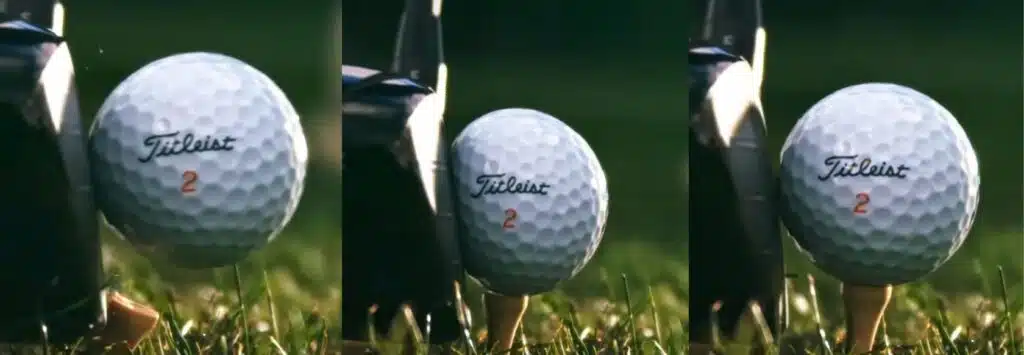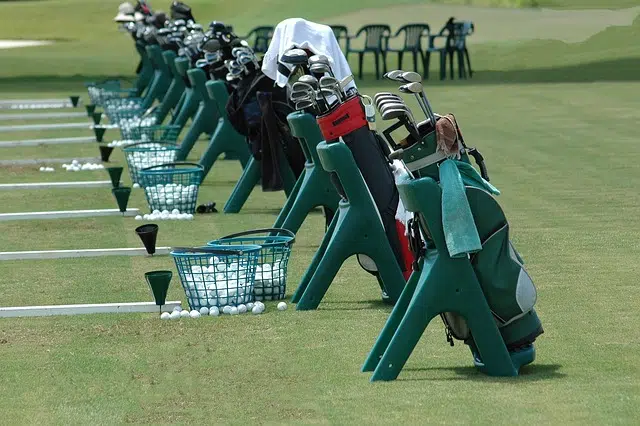The key to compressing a golf ball is in your lower body movements. You’ll want to initiate your downswing with your hips, often called a “hip bump” or slide.
To do this, push off with your right foot as you finish your backswing, causing a leftward ‘slide’ of the hip.
Although you won’t want to miss the step-by-step process below, including drills, and the slight differences when hitting irons and drivers.
I don’t think compressing the golf ball is just about adding power; it’s about technique, timing, and understanding the mechanics. I’ve seen seasoned golfers struggle, and new golfers figure it out quickly.
But if you’ve ever watched a professional golfer strike the ball, you might have noticed a distinct “crisp” sound. This sound results from compressing the golf ball – and I hope by the end of this post, you’ll have a plan to improve your golf ball compression.
Read more: Golf ball compression guide with +30 top brands
Step-By-Step Guide To Compressing A Golf Ball
After you initiate the hip bump on your downswing, this shifts your center of gravity in front of the ball through this motion, and you position yourself to connect with the ball before hitting the ground, resulting in a downward strike.
[To compress a golf ball] we know we want to hit down on the ball, but not too much. A feel that I would love for you to try is… On the way down [in your swing], get that club head about 2 inches off the ground and try to maintain it at that 2 inches off the ground for as long as possible [while swinging through the ball]. What are we doing? We’re shallowing out our angle of attack.Andrew Rice, 50 Best Golf Teachers in America and featured guest author on Golfspan
Pro tip: Observing professional golfers in slow motion will highlight that this lower body motion precedes the upper body and arms in commencing the downswing.
Here’s a complete step-by-step guide to compressing a golf ball:
1. Correct Ball Position
For short irons, position the ball in the middle of your stance. For mid-irons, a slightly forward position works best, while for longer clubs, position it more toward the inside of your lead foot. These ball positions will encourage a descending blow.
2. Forward Shaft Lean
Ensure that your hands are ahead of the clubface at the point of impact. This promotes a de-lofted clubface, ensuring the ball is struck with the right part of the club, thus compressing it effectively. This means your attack angle will be right.
3. Shift Your Weight To Front Foot
Begin your swing with a slight majority of the weight on your back foot. As you swing down, transfer that weight to your front foot. This dynamic weight shift ensures a powerful downswing, helping compress the ball.
4. Strike Down on the Ball
For irons, the aim should be to hit down on the ball rather than scooping it. This downward motion compresses the ball against the ground and the clubface, giving it a more piercing trajectory.
5. Maintain a Steady Spine Angle
Your spine angle, established at the address, should remain consistent throughout the swing. Changing the spine angle during the swing can lead to mishits or scooping the ball.
How To Compress The Golf Ball With Irons

To compress the ball with irons, here are the basic fundamentals you should look to nail.
- Ball Position: Ensure the ball is centrally located, usually aligned with the logo on your shirt.
- Weight Distribution: Leaning slightly on your leading foot (about 60%) is optimal.
- Downward Strike: Irons are designed for a descending blow. Ensure the clubhead is moving downward at impact.
- Follow Through: Rotate your hips and shoulders fully. Your belt buckle should face the target at the end of your swing.
Drawing from experience, practicing drills like the “divot drill,” where you focus on hitting the turf after the ball, can help achieve the right compression.
How To Compress The Golf Ball With Driver
Here are the basic fundamentals you should look to nail using a driver.
- Ball Position: Keep the ball forward, aligned with the inside of your leading foot.
- Tee Height: Half of the ball should be above the clubhead when teed up.
- Upward Strike: Unlike irons, drivers are designed for an upward hit. This means striking the ball on your upswing.
- Stable Base: A wide stance ensures stability, and it’s something I’ve found useful during my own practice sessions.
When I trialed drivers with different lofts and shaft flexes, I discovered that the right equipment also plays a role in how effectively you can compress the golf ball.
Golf Ball Compression Ratings
To compress your golf ball, you must buy the right golf ball for your swing. Low compression balls are best for beginners. At the same time, hard balls are best for a high swing speed swingers. To aid in understanding, golf balls have compression ratings. This rating indicates the ball’s hardness and how much it will deform upon impact.
- A higher rating (100 and above) means the ball is harder and suitable for players with a higher swing speed.
- A lower rating (80 and below) means the ball is softer and suitable for players with slower swing speeds.
| Compression Level | Ball Feel |
| 100 and above | Hard ball |
| 80 – 100 | Medium softness |
| 80 and below | Soft ball |
In my experience, understanding your own swing speed and matching it with the right compression can significantly improve your game. Check out our list of low compression golf balls for seniors.
Tips To Master Golf Ball Compression

1. Drills To Compress The Golf Ball
- Divot Drill: After hitting the ball, you should have a divot (a small piece of turf removed during a stroke). The divot should start after the ball’s position, indicating a downward strike.
- Towel Drill: Place a towel 4-6 inches behind your ball while practicing. Your goal is to hit the ball without hitting the towel, encouraging a downward strike.
2. Choose The Right Golf Ball
We often ask ourselves, ‘what golf ball should I use?’. Different golf balls have varying compression ratings. Ensure you choose one that matches your swing speed. Higher swing speeds generally require balls with a higher compression rating and vice versa.
3. Strength And Flexibility Training
Building strength, especially in the core, can aid in achieving better compression. Likewise, maintaining flexibility, particularly in the hips and shoulders, ensures a full range of motion, allowing for a more potent downswing.
4. Regular Feedback
Using launch monitors or seeking feedback from a coach can provide insights into your ball compression. This regular feedback helps in making the necessary adjustments.
What Is Golf Ball Compression?

Golf ball compression refers to how a golf ball shrinks when struck. Imagine squeezing a foam ball and watching it regain shape after releasing it. That’s essentially what happens with a golf ball, albeit on a much smaller scale and much faster.
Why is compressing a golf ball important? Compression ensures optimal energy transfer from the club to the ball. Properly compressing the ball also helps achieve the desired backspin, ensuring the ball remains stable during flight.
What Are The Benefits Of Compressing A Golf Ball Correctly?

Compressing a golf ball correctly offers multiple benefits.
Firstly, it maximizes distance, ensuring that you get the most out of every swing. Proper compression leads to optimal ball spin, which in turn improves trajectory and ball flight, resulting in straighter shots.
Additionally, a well-compressed ball provides consistent feedback, allowing golfers to feel a clean, crisp connection between the club and the ball. Over time, mastering this skill not only boosts confidence but enhances overall gameplay, as players can better control their shots under varying course conditions.
How Does Ball Compression Differ Between Golf Club Types?

Ball compression can vary based on the club you’re using. For instance, drivers, designed for distance, work best when the ball is compressed optimally to achieve a high launch and low spin. Irons, on the other hand, are crafted for precision.
When using an iron, proper compression ensures the ball has a consistent and controlled trajectory, aiding in landing the ball on the desired target.
Wedges require a slightly different compression technique, as they are often used for shorter shots where spin control becomes crucial. Understanding the nuances of compression for each club type is key to elevating your game.
FAQs
How Can I Tell If I’m Compressing The Golf Ball?
Besides the distinct sound, well-compressed shots will have a penetrating ball flight, increased distance, and will generally feel solid at impact.
Do Woods And Drivers Require Ball Compression?
While the principle is similar, woods and drivers have a different impact dynamic due to their design. Rather than a steep angle, a slightly upward or level angle of attack is ideal.
How Does Ball Compression Relate To Ball Spin?
When compressed effectively, the ball interacts with the grooves on the clubface, imparting spin. This spin, especially backspin, stabilizes the ball during flight.
Sam has been playing golf for over 20 years and founded Impact Golfer. As a teenager, he discovered his love for the game using his grandad’s clubs, including a wooden driver. As a golf obsessive, Sam plays whenever possible, regularly competing in matchplay with his friends and in tournaments at his local club. He's fortunate to have a close friend who is a club pro– he has tested almost every type of equipment on the market (no freebies yet).
Sam has a handicap index of 13 and likes playing at the Metro Golf Centre near his home in London. He putts with a Taylormade Spider because Rory uses it but regrets selling an old Scotty Cameron putter on eBay.
- Best score: 94
- Favorite club: TaylorMade Stealth Driver
- Favorite putter: Bought a TaylorMade Spider because Rory uses it, but spend most of my time on greens yearning for the Scotty Cameron I sold on eBay.
- Favorite food at the turn: Baguette. Sausages. Bacon. HP Sauce.







